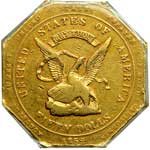
|
Sale 75
September Pre Long Beach
| Lot |
Photo |
Description |
Realized |
Lot 2244 |
 |
August Bechtler, 1 DOLLAR CAROLINA, 27 Gr. 21 Carats PCGS graded Genuine AU Details. Filed rims. Still a nice coin and representative of this historic Carolina Minter whose coinage were accepted at par with regular USA gold coinage (PCGS # 10040) Estimated Value $700 - 750
View details and enlarged photos
Check results on similar lots
| Realized
$1,380 |
Lot 2245 |
 |
1852 U.S. Assay Office $50 "slug", 887 THOUS. Reeded edge. PCGS graded VF-35. CAC Approved. A pleasant looking "slug" with no serious damage on bumps. Just the normal allotment associated with this circulated grade. Clear date with readable legends.
Why a State Assay Office issuing octagonal gold ingots/slugs? According to historian Donald Kagin, "One may wonder why, with such a meager amount of small denomination currency, the state did not resort to issuing paper money, as did the Mormons. The California State Legislature wrote into its Constitution that it would "prohibit by law any person or persons, association, company, or corporation from creating paper to circulate as money."
"Quite simply, it was not legal. State issues of paper currency were unconstitutional; private issues of paper currency were outlawed by the California state constitution. But neither was private gold coining legal � at least it certainly was not authorized by the Federal Government. The difference was that the public was prone to accept gold coins, sometimes even those that were debased, whereas there existed a nationwide aversion to paper money, probably arising from the disastrous effect of the 1837 paper money speculation elsewhere in the United States. While some states and their cities issued scrip bearing interest to fund public debts, little private or public currency was issued in the western United States prior to 1858. Vain attempts, however, were made by enterprising companies in California to relieve the dearth of small denomination currency in the West.
"Practically every newspaper printed editorials against the currency issue citing its unconstitutionality, the possibility of setting a dangerous precedent, and the deceit of Marriott & Co. by its unauthorized use of a banker�s name to sell its currency. It can be seen by this abortive attempt at a paper currency why the experiment was not tried again for several years."
The products of the State Assay Office were contemporaneous with the Second Series of private gold coins. The law establishing this assay office was passed along with a companion bill which would have eliminated private gold coinage, had it been enforced.
The State Assay Office of California was a unique institution in our nation�s history. It was the only mint to operate in this country under the authority of a state, after 1789. Its issues (though never challenged in the courts) may have been questionable under the United States Constitution, which forbade any state to issue coins or currency. These issues were the first ingots to be called "slugs," a name later used to describe any private coin, particularly those used today in coin-operated machines.
The 1852 $50 Assay Office octagonal "slug," called an adobe in local trade, as perhaps these pieces resembled bricks in a way, was a mainstay of California commerce in the early Statehood days. Such pieces were used in large transactions, being the coin of choice, as paper money remained illegal in the state throughout the Gold Rush period; moreover, lesser denomination gold coins were not plentiful.
The octagonal $50 pieces were last minted in 1852, but were continued in use for much of the rest of the decade of the 1850s. Many found their way to the Philadelphia Mint, where they were melted into bullion, then struck into federal denominations. Some pieces figured prominently in the shipwreck of the S.S. Central America, lost at sea in 1857, which carried a small supply of such pieces, apparently destined for Philadelphia. It is likely that by 1860 most slugs disappeared. By this time the San Francisco Mint had been in operation since 1854, and regular issue double eagles were plentiful in commerce (PCGS # 10217) Estimated Value $20,000 - 22,000
View details and enlarged photos
Check results on similar lots
| Realized
$35,650 |
|
|